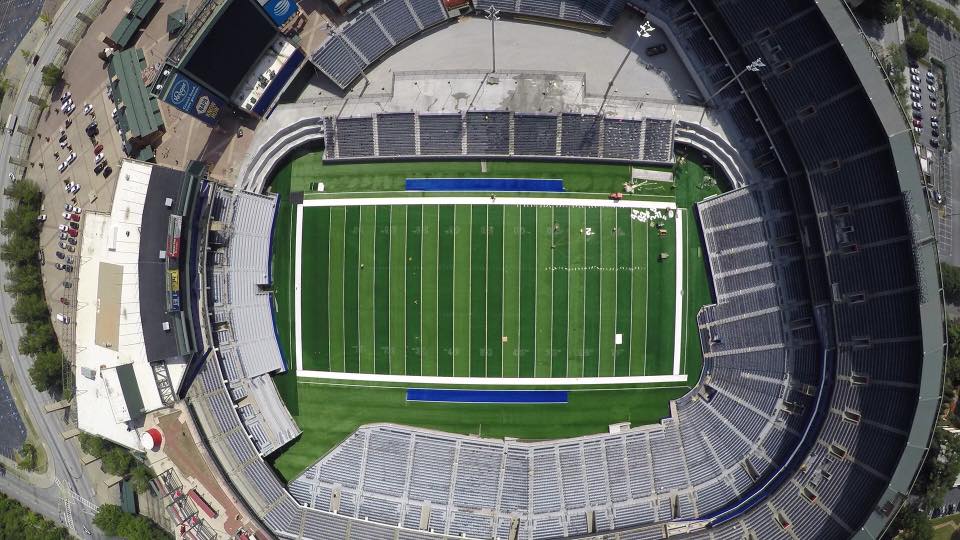The lineup of Alliance of American Football stadiums is set for its inaugural season, as the upstart league has unveiled all eight teams for 2019.
Starting play next February, the AAF is a new attempt to create a professional spring football league. Backed by co-founders Charlie Ebersole and Bill Polian, the league has unveiled the eight teams that will compete in its first season. The venues that these teams will play in cover a broad range, spanning from college football stadiums to multipurpose facilities and even a few former NFL stadiums.
What follows is a full rundown of Alliance of American Football stadiums for its inaugural season:
Atlanta—Georgia State Stadium
Georgia State Stadium might be entering only its second season as a college football facility, but the structure has had a unique life in its 22 years of existence. After being constructed as an Olympic stadium for the 1996 summer games, it was converted into Turner Field—the home ballpark of the Atlanta Braves from 1997-2016. When the Braves moved to the new SunTrust Park in suburban Cobb County last year, the stadium was repurposed again—this time for Georgia State’s football program.
Birmingham—Legion Field
First opening in 1927, Legion Field will hold the distinction of being the oldest facility in the AAF when the league begins play. The facility has been used for college football for decades and has played host to other professional spring football teams before, including perhaps most notably the Birmingham Stallions (USFL) and the Birmingham Thunderbolts (XFL).
Memphis—Liberty Bowl Memorial Stadium
Opening in 1965 as Memphis Memorial Stadium, the Liberty Bowl Memorial Stadium has been home to University of Memphis football and the annual Liberty Bowl game throughout its history. Like Legion Field, it has experience with past spring football circuits, including the USFL (Memphis Showboats) and the XFL (Memphis Maniax). It has also stood in as a temporary home to an NFL team, playing host to the Tennessee Oilers in 1997 before the franchise moved to Vanderbilt Stadium in 1998 and opened its new Nashville facility (now known as Nissan Stadium) in 1999.
Orlando—Spectrum Stadium
Spectrum Stadium originally opened in 2007 as Bright House Networks Stadium, and has served as the home to University of Central Florida football throughout its history. The university’s Board of Trustees recently approved an agreement that calls for the Orlando AAF team to play home games at Spectrum Stadium for three years, giving the facility a professional tenant during the spring months.
Phoenix—Sun Devil Stadium
Located in Tempe, Sun Devil Stadium is home to Arizona State University football. The venue is currently undergoing a major renovation that will amount to its most significant changes since opening in 1958. The highlight among Sun Devil Stadium’s stints as a professional facility was when it hosted the NFL’s Arizona Cardinals from 1988-2005. It is also just one of two AAF stadiums that has been home to a Super Bowl, as it hosted Super Bowl XXX in 1996.
Salt Lake City—Rice-Eccles Stadium
Opening in 1998 for University of Utah football, Rice-Eccles Stadium also holds the distinction of having been used for opening and closing ceremonies during the 2002 Winter Olympics. It was also used for a time as an MLS venue, serving as home to Real Salt Lake from 2005-2008.
San Antonio—Alamodome
Having hosted the most recent NCAA Men’s Basketball Final Four, the Alamodome is no stranger to high-profile events. It has also proved to be adept to multiple purposes, with a range of former uses that includes the permanent home of the NBA’s Spurs and one of the temporary homes used by the New Orleans Saints after the Superdome was damaged by Hurricane Katrina in 2005. The Alamodome is currently home to the University of Texas at San Antonio’s football program and the annual Alamo Bowl.
San Diego—SDCCU Stadium
SDCCU Stadium is not the oldest facility in the league, but it might be the most recognizable. First opening in 1967, the former San Diego Stadium (later Jack Murphy Stadium, later Qualcomm Stadium) was home to MLB’s Padres from 1969-2003 and the NFL’s Chargers until they relocated to Los Angeles after the 2016 season. The facility has hosted three Super Bowls and saw two World Series during its time hosting the Padres. SDCCU Stadium is currently home to San Diego State University football, but it is facing an uncertain future. Competing ballot proposals for the site—one calling for a new SDSU stadium and surrounding amenities, and another planning for a new MLS stadium as an anchor to a large development—will be considered by voters in November. Approval of either is expected to lead to the facility being demolished in the coming years, but the AAF San Diego team has a one-year agreement in place to cover the 2019 season.
Image courtesy Georgia State University athletics.

